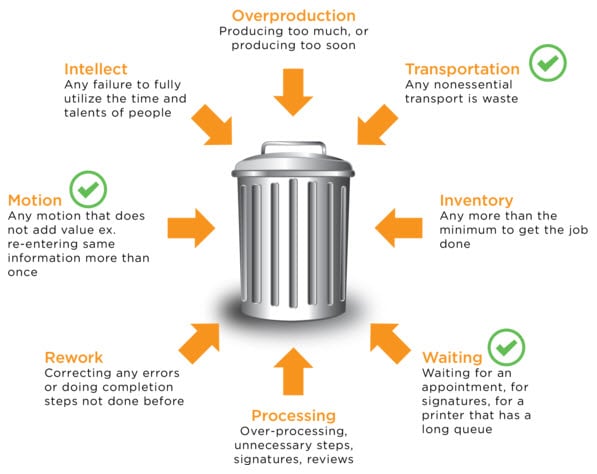While it’s important for lean consultants to stay on top of current trends in lean manufacturing, it is difficult to keep up with advances in technology and new opportunities. For instance there is new warehouse cart technology available that reduces waste. Here are five new trends in lean manufacturing we believe you will want to know about:
Get the free "NEW TRENDS IN LEAN MANUFACTURING THAT
WILL IMPACT THE FUTURE" White Paper Here.
 1. Strength-Based Lean Thinking
1. Strength-Based Lean Thinking
Most applications of lean thinking begin with an assumption that there is a theoretical “perfect state” for each organizational process and that the current state deviates from the perfect state due to inefficiencies and waste.
The strength-based approach to lean has a different focus. Instead of focusing on what is not working and inefficient, it teaches how to identify what is already working efficiently and generates value in existing processes and systems (this is called “strength focus”).
The strength-based approach to lean is more natural to work with and more sustainable in the long term.
Leveraging current or past knowledge, and accessing experiences and successes from within the system, are great resources for the next generation of improvement initiatives. They also provide motivation for everyone to face the challenges and opportunities ahead.
2. Lean Labor
Razor-thin margins, pressures to cut costs, increased competition from existing vendors as well as new players in the market have made it tough to remain in the manufacturing sector today, especially when it comes to gaining a true competitive edge.
For these reasons, it is important for manufacturers to increase productivity, control costs, optimize labor resources, and align them with the most important project or goal. Conceptually, all of this sounds good, but for many manufacturers, the question remains: How?
Lean labor can help manufacturers improve the way they align employees with production demand. For example, scheduling applications — a critical component to a larger workforce management solution — helps shift supervisors create each shift with the right mix of employees and skills. Not only does this increase total production and help achieve revenue targets, but it also helps decrease overtime costs for any replacement workers who may have to be called in to fill a gap.
While it is true that it is extremely tough to compete in the manufacturing industry today, lean labor can help. With lean labor, manufacturers can acquire a proven way to gain new efficiencies, reduce and control costs, and increase overall productivity. In turn, this allows them to focus on revenue-generating activities, strengthen the bottom line, and increase their overall competitive advantage.
3. 3-D Printing and Lean
It’s no coincidence that 3-D printing is gaining fame as lean manufacturing is on the rise. Lean manufacturing and 3-D printing go together naturally. While 3-D printing isn’t a new technology, it is getting more attention lately because of the potential cost implications for everyone involved. The leaner you are, the more you can save and create. The catalyst is 3-D printing.
Below are a few reasons why 3-D printing and lean manufacturing go hand in hand.
> Easier Prototyping
> Easily Customized Products
> More Creativity and Efficiency
> More Consistency
> Shorter Lead Times
> Local Manufacturing
> Lower Prices
> New Consumer Demand
Customers and businesses are becoming aware of the efficiencies that 3-D printing is making possible. This fuels customer’s excitement regarding customized products, resulting in potential cost savings associated with it, for both the manufacturer and the customer. With this excitement comes innovation, and with innovation comes new ways to be lean in manufacturing. Therefore, one way to jumpstart lean manufacturing is with 3-D printing. It will also likely lead to newer, leaner processes.
4. IOT and Lean
Some experts are calling it the “fourth industrial revolution.” The Internet of Things (IoT) is estimated to be roughly a $14 billion market at present, and predictions claim it will reach $50 billion by 2020.
We are at the forward tip of the iceberg for IoT. Academics at Georgia Tech and elsewhere foresee a potential $19 trillion market, with manufacturing gains being a big part of that total.
Lean manufacturing will not fade away in this fourth industrial revolution, quite the opposite. IoT supports lean processes, and it enables a truly lean enterprise by delivering better metrics to drive increased efficiency and productivity, tighter integration with key clients and suppliers, better coordination among divisions, and both, increased manufacturing safety and reduced downtime, according to Bill Morelli, director of internet of things, M2M and digital for IHS.
If manufacturers can get it right, IoT offers substantial efficiencies and can greatly improve lean processes.
Here are five ways how this can be made possible:
1. Real-time data for faster optimization
2. Better process control
3. Tighter integration with customer demand
4. Deeper supplier integration
5. Lean custom manufacturing
There are not enough organizations employing these methods as of yet, but many feel that the industry is on the edge of an IOT revolution.
Executives from Cisco, Lenovo, and BT Group discussed the Internet of Things at Fortune’s Global Forum. This video might shake up your perception of the future with the Internet of Things:
5. Lean-Driving Green Manufacturing
Green manufacturing is a method of manufacturing that minimizes waste and pollution. Lean manufacturing is the system, which aims towards the elimination of the waste from the system with a systematic and continuous approach. Operations management teams attempt to balance costs with revenue to achieve the highest net.

Green manufacturing is a method of manufacturing that minimizes waste and pollution achieved through research and process design. It is also a method that supports a sustainable way of producing products and services that do not harm the environment or human beings in general. Green manufacturing goals are also aimed to conserve natural resources for future generations. The benefit of green manufacturing is that it creates a great reputation in front of the public, saves useless costs, and promotes research and design.
Even without explicitly targeting environmental results, lean efforts can yield sufficient environmental benefits. However, because environmental wastes and pollution are not the main focal points, these achievements may not be considered in the normal scheme of lean.
Finally,
...as Lean transformations are truly cultural transformations, executives are matching their Lean process investments dollar-for-dollar with cultural investments designed to create an enterprise-wide Lean language driving predictable customer service performance and global focus on waste elimination. It will not be an easy task considering the IoT revolution is almost upon us, and even the best experts are unable to predict the impact fully.
This has been only a brief snapshot and sample of our new white paper we recently published. CLICK HERE if this is a topic that interests you. You will find our free white paper offers a more extensive overview of the new trends in lean manufacturing.
Get the free "NEW TRENDS IN LEAN MANUFACTURING THAT
WILL IMPACT THE FUTURE" White Paper Here.
